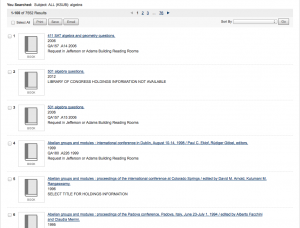“Current Research on and Use of FRBR in Libraries”
8am on Sunday, June 24, 2012
Speakers: Erik Mitchell & Carolyn McCallum, Thomas Hickey, Yin Zhang & Athena Salaba, Jennifer Bowen
Presentation 3 of 4
“Research, Development and Evaluation of a FRBR-based Catalog Prototype”
Yin Zhang & Athena Salaba
Presentation Slides
Presentation outline:
- background of the project
- research and development of the project
- user evaluation of the project
- conclusion/next steps
Background
Zhang began the presentation by discussing the background of the project. While FRBR has the potential for libraries to develop better and more effective catalogs and discovery tools, there is not much in the way of guidance for how to implement FRBR. User studies are still few and far between. KSU received IMLS funding to develop and research FRBR-based systems. As part of that project, KSU conducted a series of user studies.
Methodology
1. Run user evaluation studies on FRBR-based catalogs already in existence
2. Put together a FRBR-ized data set
3. Develop an initial set of displays
4. User feedback on the developed prototypes
Step One
The first step was to evaluate existing FRBR-based catalogs. They evaluated three existing FRBR-based catalogs for user experiences and support for the FRBR tasks: OCLC WorldCat.org, FictionFinder, and Libraries Australias. The results of the evaluation served as the basis for their own FRBR prototype catalog.
Step Two
The next step was to extract Library of Congress bib records and authority records from WorldCat. They used OCLC’s Workset algorithm to identify works, but applied their own algorithm to identify expressions and manifestations. The results of this were used to develop FRBR-based displays.
Step Three
In the third step, they developed the layouts for the FRBR-based displays based of:
- works from an author search
- works from a subject search
- works from a title search
- expressions from a language/form search
- manifestation (slide 7)
Step Four
Finally, they sought user feedback on the interface design. The study participants were interviewed using printed display layouts as prompts and asked about data elements and functions. The feedback was incorporated into the final prototype catalog programming.
Here I have appended a screenshot of the prototype catalog search results taken from presentation slide 10 and a screenshot taken of LC’s current catalog search results where I tried to run approximately the same search.
FRBR prototype catalog

Traditional catalog

Instead of the gazillion search results all strung out over many pages as seen in the traditional catalog (is this another record for the same thing that I already looked at three pages ago?), in the prototype, the records are gathered together under the author/title work sets and then by form and language. The resulting display seems cleaner and more compact, while still presenting plenty of information. It seems so obvious to me that catalogs should have always worked this way.
Study Design
Next Salaba discussed the study design for having users actually evaluate the FRBR prototype. They used a comparative approach: with the same set of records, they had users search using both the traditional catalog and the FRBR prototype catalog. The study group contained 34 participants and data was collected via observations, interviews, audio recordings and screen captures.
The participants were given two kinds of search strategies to pursue. The first set of searches were predefined and users were asked to evaluated the resulting displays. In the second set, participants were given criteria and allowed to use their own search strategies.
Findings
Overall, most users (85%) preferred the FRBR prototype for all of the searches they did. The table on slide 14 breaks down the findings into the categories of language or type of materials, author, title, title and publication information, entertainment, research, and a general topic. The biggest difference in searching the two catalogs was that the FRBR prototype allowed users to find expressions. Since the current catalog only provides access at the manifestation level and does not group by language or format, this cannot really be a surprise.
Features that the participants found “helpful”:
Grouping of results by work and expression (65%)
Refining results (24%)
Alphabetical order of results display (15%)
Interface appearance (24%)
Features that participants thought needed improvement:
More detail before manifestation level display (15%)
Prefer individual manifestation level results (9%)
Listing a resource under each language of a multi-language resource (3%)
88% of participants thought that clustering the resources by work/expression/manifestation made it easier to find things. 91% thought that the navigation made sense and was helpful in performing searches. One participant found the FRBR prototype less helpful for searching for a specific title, but helpful when searching for a specific topic.
Conclusions
Salaba noted the importance of user input into the design and implementation of FRBR-based catalogs. The study showed that users can successfully complete searching tasks using the FRBR-based catalog and that users do understand and can navigate the FRBR-based displays.
Finally, Salaba stated that more research is needed into other FRBR implementations, with more studies comparing those implementations. She noted that other issues include:
- FRBRization algorithms
- Existing MARC records
- Attributes and relationships
- FRBR-based catalogs the support user tasks
- Displays
Additionally, it is unknown at this point how RDA and Linked Data will work into the whole equation.
Related links:
Article (2007): Critical Issues and Challenges Facing FRBR Research and Practice
Article (2007): From a Conceptual Model to Application and System Development
Poster (2007): User Research and Testing of FRBR Prototype Systems
Article (2009): User Interface for FRBR User Tasks in Online Catalogs
Article (2009): What is Next for Functional Requirements for Bibliographic Records? A Delphi Study
Book (2009): Implementing FRBR in Libraries: Key Issues and Future Directions
Presentation for the ALA 2010 Annual Conference: FRBRizing MARC Records Based on FRBR User Tasks
Presentation for ASIST 2010 Annual Conference: FRBR User Research and a User Study on Evaluating FRBR Based Catalogs
An abstract for a presentation at a panel discussion at ASIST 2010: FRBR Implementation and User Research
An abstract for a presentation at a panel discussion of FRBR at ASIST 2011: Developing FRBR-Based Library Catalogs for Users


